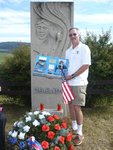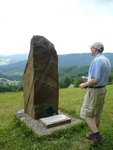seesul
Senior Master Sergeant
Hello,
Jimmy Weiler was a pilot of B-17G, 42-32048, shot down on Aug. 29,1944 and crashed few miles away from my born town.
Last year, Jimmy´s nephew, Todd Weiler, visited us here to see the crash site and museums. In the meantime, Todd became a co-historian of 2ndBG assn.
Here is a story of Jimmy´s silver bracelet...
Second Lt. James A. Weiler of Burlington sat down to write his brother Joe a quick letter before hitting the sack. He and his crew had an important mission in the morning.
In keeping with tight security, he didn't tell his brother where behind the Nazi lines the bombing raid was headed.
"I see my share of war kid and don't ever think I don't. We'll compare notes when together and in a morbid mood sometime...," Weiler, 22, wrote. "All my lads are OK and still going strong. I intend getting them all back to the States just the way I brought them over."
Weiler's intention to keep his crew safe was futile, and the letter was the last the pilot ever wrote.
Weiler and nine of his crew of 10 were killed when the B-17 flying fortress they were in was hit by fire from a German fighter plane in the skies near Krhov, Czechoslovakia, a mere five minutes from their target.
Ten aircraft - the entire 20th squadron plus three planes - with 100 airmen were shot down that day, Aug. 29, 1944, on mission 263. Forty-one of the men were killed and the rest were captured in what history would dub the Battle of the White Carpathian Mountains.
Though not a World War II veteran himself, Todd Weiler is the assistant historian of the 2nd Bomb Group, an organization of veterans who flew missions in WW II. He grew up knowing his uncle Jim had bravely given his life in the war. But he had no idea that someday his uncle's story would draw him into hours of research, which would lead to a quest on the other side of the Atlantic.
It is a silver bracelet engraved with James Weiler's name that is central to this story, which is mapped with twists and turns. The bracelet had been given to the young pilot to commemorate his graduation from Army Air Corps flight school in Pecos, Texas, in 1943.
In the hours after the battle, as the wreckage was still smoldering, a Krhov resident, Anton Kasperek, found the bracelet.
Kasperek tried to return it to the airman's family, but a language barrier with the Red Cross after the war foiled his efforts. Then the rise of the Soviet Union stalled his intentions, as it would have been dangerous for this Czech farmer to pursue the search through the U.S. military.
In 1965, Kasperek gave the bracelet to an actor friend Miloslav Holub, who was headed to the Montreal World Film Festival, one step closer to the United States. He hoped the bracelet somehow would find its way to Weiler's family.
Seated on the plane next to Holub was Marie Spelina, whose husband, Jozka, was a technical officer with an international civil aviation organization. Marie Spelina took the bracelet and gave it to her husband, who understood the importance of returning it to Weiler's family.
Jozka Spelina took the bracelet to the U.S. consulate in Montreal, who advised him to contact the Pentagon. But his search got bogged down in red tape.
"The Pentagon told him to contact the Air Force headquarters in Texas. He did, but he (James Weiler) wasn't in the Air Force - he was he was in the Army Air Corps," Todd Weiler explained.
Jozka Spelina finally got a 22-year-old next-of-kin address for James Weiler's mother (Todd's grandmother), Nora, and wrote a letter to her.
"Thanks to Burlington being a nice small town, the postman had the wherewithal to know that Nora Weiler was living at a different address, and Jozka's letter finally got to Nora in January of 1966," Todd Weiler said.
The bracelet finally arrived back with the Weiler family, with the details of its discovery and journey.
Source:
Kenosha News Online
Jimmy Weiler was a pilot of B-17G, 42-32048, shot down on Aug. 29,1944 and crashed few miles away from my born town.
Last year, Jimmy´s nephew, Todd Weiler, visited us here to see the crash site and museums. In the meantime, Todd became a co-historian of 2ndBG assn.
Here is a story of Jimmy´s silver bracelet...
Second Lt. James A. Weiler of Burlington sat down to write his brother Joe a quick letter before hitting the sack. He and his crew had an important mission in the morning.
In keeping with tight security, he didn't tell his brother where behind the Nazi lines the bombing raid was headed.
"I see my share of war kid and don't ever think I don't. We'll compare notes when together and in a morbid mood sometime...," Weiler, 22, wrote. "All my lads are OK and still going strong. I intend getting them all back to the States just the way I brought them over."
Weiler's intention to keep his crew safe was futile, and the letter was the last the pilot ever wrote.
Weiler and nine of his crew of 10 were killed when the B-17 flying fortress they were in was hit by fire from a German fighter plane in the skies near Krhov, Czechoslovakia, a mere five minutes from their target.
Ten aircraft - the entire 20th squadron plus three planes - with 100 airmen were shot down that day, Aug. 29, 1944, on mission 263. Forty-one of the men were killed and the rest were captured in what history would dub the Battle of the White Carpathian Mountains.
Though not a World War II veteran himself, Todd Weiler is the assistant historian of the 2nd Bomb Group, an organization of veterans who flew missions in WW II. He grew up knowing his uncle Jim had bravely given his life in the war. But he had no idea that someday his uncle's story would draw him into hours of research, which would lead to a quest on the other side of the Atlantic.
It is a silver bracelet engraved with James Weiler's name that is central to this story, which is mapped with twists and turns. The bracelet had been given to the young pilot to commemorate his graduation from Army Air Corps flight school in Pecos, Texas, in 1943.
In the hours after the battle, as the wreckage was still smoldering, a Krhov resident, Anton Kasperek, found the bracelet.
Kasperek tried to return it to the airman's family, but a language barrier with the Red Cross after the war foiled his efforts. Then the rise of the Soviet Union stalled his intentions, as it would have been dangerous for this Czech farmer to pursue the search through the U.S. military.
In 1965, Kasperek gave the bracelet to an actor friend Miloslav Holub, who was headed to the Montreal World Film Festival, one step closer to the United States. He hoped the bracelet somehow would find its way to Weiler's family.
Seated on the plane next to Holub was Marie Spelina, whose husband, Jozka, was a technical officer with an international civil aviation organization. Marie Spelina took the bracelet and gave it to her husband, who understood the importance of returning it to Weiler's family.
Jozka Spelina took the bracelet to the U.S. consulate in Montreal, who advised him to contact the Pentagon. But his search got bogged down in red tape.
"The Pentagon told him to contact the Air Force headquarters in Texas. He did, but he (James Weiler) wasn't in the Air Force - he was he was in the Army Air Corps," Todd Weiler explained.
Jozka Spelina finally got a 22-year-old next-of-kin address for James Weiler's mother (Todd's grandmother), Nora, and wrote a letter to her.
"Thanks to Burlington being a nice small town, the postman had the wherewithal to know that Nora Weiler was living at a different address, and Jozka's letter finally got to Nora in January of 1966," Todd Weiler said.
The bracelet finally arrived back with the Weiler family, with the details of its discovery and journey.
Source:
Kenosha News Online

















